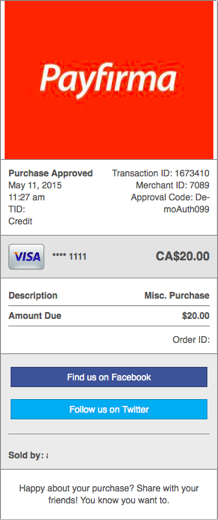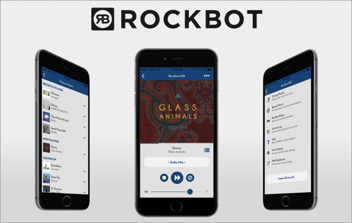This week we are happy to welcome Payfirma's CMO, Robin Jones who will be talking about how implementing modern payment solutions will make things more convenient for customers.
These days, technology is very much a part of the restaurant experience. Restaurant goers are always plugged in and are accustomed to constant connectivity in all aspects of their lives. This shift has produced a culture of convenience that demands a streamlined, simple, and automatic experience. From music to payment solutions, making things easier for your customers will forever give you a competitive advantage.
The opportunity in the restaurant industry
In this day and age, it has never been easier for businesses to accept payments any way customers want to pay. Restaurants have an opportunity to streamline the payment process by taking mobile payments on a tablet or smartphone. The innovation in the payments industry parallels consumers’ (especially Millennials) growing appetite for greater convenience, speed, and personalization. Consumers, especially millennials, are embracing digital payment solutions with open arms. In fact,
- 68% of users of alternative payments (such as mobile payments) report they are using the alternative payments methods more than last year.
- 85% of millennials say they are open to trying new banking and payment technologies.
- 62% of millennials would be comfortable connecting their payment info to an app from a retailer or service they use frequently.
Streamline your restaurant's experience
Instead of traditional terminals, some of which are still wired and stationary, restaurants that implement mobile payments can enable servers to take orders and payments directly on tablets with a mobile card reader. Taking payments via tablet opens up many possibilities, such as:
- convenient table-side payments
- easy bill splitting
- faster line busting at cafes or food trucks during peak hours
- efficient bar tab managing
All of these possibilities lead us to faster service as a result of integrating mobile technology into the restaurant experience. With mobile payment solutions, like tablets, after the order is taken, the information is sent immediately to the kitchens so chefs can start preparing food. Instead of going back to the terminal between each order, your staff can move from table to table, increasing the level of service and handling a higher volume of customers.
With mobile payments, the payment process times at restaurants are significantly reduced. Customers don’t have to waste time flagging down servers, waiting for them to drop off the bill, and coming back again to complete the transaction. With mobile payments, the process is done in one trip and in just seconds. On busy nights, all of the traditional terminals can be occupied at any given time, but with mobile payments, each server is equipped to accept, process, and present payments at the table. Faster payment processing means quicker table turnover and more business. Apple’s retail stores are a great example of how effective mobile payments execution can be; each salesperson on the floor is able to process a transaction.
Streamlining the payment process gives servers more time to provide exceptional customer service.
Real-time reporting
Reporting is important to any business but provides particular value to multi-location businesses in the restaurant industry. Data and insights help chain restaurants run a lean and agile business by looking at the bigger picture and tracking performance across multiple locations. To quote Brandon Hull from Next Restaurants, “The key, in the future, isn’t whether you should jump on board the Data bandwagon. It’s how you’ll jump on board.” When you’re thinking about your next consumer-facing deployment, including payment solutions, think about how you can use the data that solution provides to make the experience better for your customers. For example, analytics help owners make smarter business decisions by tracking hourly sales and inventory, and then adjusting labor costs. Is one store experiencing a lull while another is busy? Real-time sales reporting will provide that information, allowing managers to send staff from one location to the other to help reduce the workload.
Customize the experience
Mobile payments mean you can email receipts to customers. Emailed receipts have a number of benefits:
- social sharing
- branding opportunities
- cross-selling
- discount incentives
- instant customer feedback

Some restaurants have started implementing tablet menus, which allow patrons to order and pay right at the table. This requires additional upfront cost, but offers the opportunity to adjust menus in real time and encourages interactive engagement. While more expensive, implementing a simple, convenient solution for both businesses and users will yield long-term benefits.
Customer loyalty
Convenience breeds loyalty. This explosion of user-friendly payment methods supports the idea that businesses have tapped into: if you make things more convenient, customers will keep coming back for more.
Modern payment solutions are not only convenient, but provide a greater understanding of customer’s preferences through data. To build an effective loyalty program you must increase personalization using data that allows you to target your customers with the right offer at the right time.
Jump the counter and pay ahead

The future of mobile payments in the restaurant industry embraces technology to further simplify and streamline the payment process. In today’s mobile-driven economy, mobile ordering systems are gaining traction whereby consumers can order and pay on apps, then simply pick-up the food when it’s ready.
Mobile ordering apps are a goldmine of customer information like we mentioned above. Pertinent data, like consumers’ ordering habits and preferences, is collected, which can be used to tailor the dining experience by:
- sending coupons based on shopping habits and location
- implementing targeted mobile campaigns to specific segments
- sending push notifications or promotions via email or text
Historically, restaurants would have no way of gaining customer insight from traditional payment transactions, but with mobile ordering and paying, you can treat every guest like a regular.
Conclusion
Restaurants can use mobile payments to deliver an experience aligned with consumer preferences and expectations. Early adopters are quickly taking note and integrating mobile payments to take advantage of this speed-hungry market. Convenience, efficiency, and speed are critical ingredients in the modern consumer’s purchasing decisions.
About the author
Robin Jones is the CMO of Payfirma and has more than 20 years of experience as a marketing strategist in global technology organizations. Payfirma’s mobile payment solutions make it easy for merchants to get paid any way their customers want to buy: online, in-store, or on the move.
Follow them on Twitter: @Payfirma







